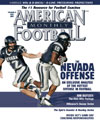AMERICAN FOOTBALL MONTHLY THE #1 RESOURCE FOR FOOTBALL COACHES
Article CategoriesAFM Magazine
|
Technology Tools You Need TodayProduct innovation and falling prices are driving the tech revolution in football.© More from this issue There’s no denying that technological advances have had a significant impact on football and coaching. In only a few decades, we’ve come from cutting and splicing 16mm game film by hand in order to analyze opponent’s tendencies to today’s state-of-the-art editing systems and software that can give coaches information and advantages never before available. Coaches today are wireless, online, hi-speed and most definitely high-tech. Product innovation and falling prices are driving the tech revolution in football. Stan Webber of Coach’s Office puts it in perspective. “In the past ten years computer technology hardware has taken a quantum leap. Personal Computer (PC) speed, memory and hard drive storage has increased nearly ten-fold. Yet the price of a typical desktop or laptop PC is half the price it was a decade ago. ....The full article can only be seen by subscribers. Subscribe today!
|
|
|||||||
| HOME |
MAGAZINE |
SUBSCRIBE | ONLINE COLUMNISTS | COACHING VIDEOS |
Copyright 2025, AmericanFootballMonthly.com
All Rights Reserved





